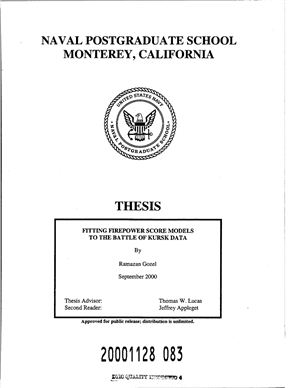Военно-морская школа последипломного образования (Naval
postgraduate school, Califoia), 2000. – 187 с. (на англ. яз.).
Специальность: моделирование и виртуальная реальность (Мodeling,
virtual environments, and simulation).
This thesis applies several Firepower Score attrition algorithms to
real data. These algorithms are used in highly aggregated combat
models to predict attrition and movement rates. The quality of the
available historical data for validation of attrition models is
poor. Most accessible battle data contain only starting sizes and
casualties, sometimes only for one side. A detailed database of the
Battle of Kursk of World War II, the largest tank battle in
history, has recently been developed by Dupuy Institute (TDI). The
data is two-sided, time phased (daily), highly detailed, and covers
15 days of the campaign. According to combat engagement intensity,
three different data sets are extracted from the Battle of Kursk
data. RAND's Situational Force Scoring, Dupuy's QJM and the ATLAS
ground attrition algorithms are applied to these data sets. Fitted
versus actual personnel and weapon losses are analyzed for the
different approaches and data sets. None of the models fits better
in all cases. In all of the models and for both sides, the Fighting
Combat Unit Data set gives the best fit. All the models tend to
overestimates battle casualties, particularly for the Germans.
Introduction.
Previous validation studies on combat modeling.
History and data on the battle of Kursk.
Application of different methodologies to the data on the battle of Kursk.
Conclusions and recommendations.
Previous validation studies on combat modeling.
History and data on the battle of Kursk.
Application of different methodologies to the data on the battle of Kursk.
Conclusions and recommendations.

